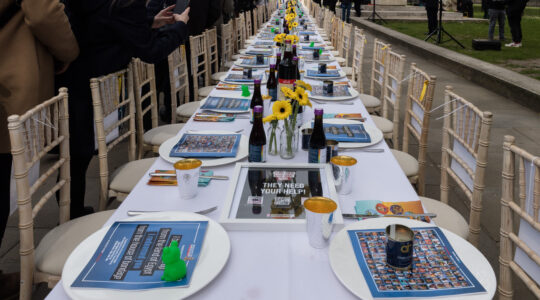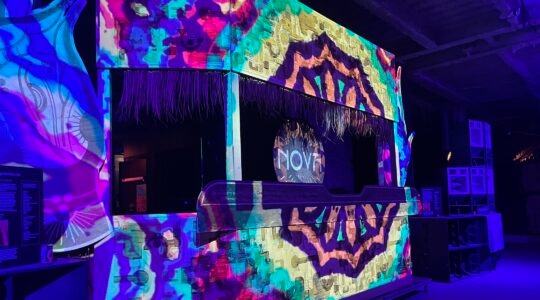JERUSALEM (JTA) — At first glance, Reut looks like a typical religious Israeli high school.
The first day starts with Shacharit, the morning service. The boys, all wearing kippot, sit separately from the girls. Only boys lead the service. There’s plenty of singing and clapping. The service lasts more than an hour.
But on closer inspection, a few things are different. Unlike religious schools, most of the girls here are wearing jeans and many have piercings in various parts of their bodies. Many of the boys are not wearing tefillin, although many are wearing earrings. Some even have both.
Reut, a Jerusalem middle school and high school, defies the usual Israeli dichotomy of “secular” or “religious.” The school calls itself a pluralistic community, and it is part of a third stream of education that tries to bridge the gaps between secular and religious Israelis.
“Spirituality doesn’t have to be religious,” said principal Avital Levy-Katz, 42. “We teach the children that they are part of a community — in their family, their school, in Israel and in the Jewish nation. Being part of a community entails rights and responsibilities.”
Nothing is simple in Israel, and education is no exception.
Many of the 1.97 million students who started school this week will attend either “state” schools or “state religious” schools. In addition there are hundreds of haredi Orthodox schools, which are funded by the Ministry of Education but do not have to follow the state curriculum. Arab students, about 20 percent of Israel’s population, have their own schools and curriculum.
The complexity does not end there. Some 120,000 students study in a third stream of education that defines itself as “pluralistic” or “integrated.” Religious and secular students study together, and Jewish texts are emphasized. Each of the 320 schools finds it own way to do this.
“Israeli society is becoming more and more polarized,” said Rabbi Michael Melchior, the initiator of the push for pluralistic schools and a former Knesset member. “The secular schools have disconnected themselves from any kind of Judaism, and the religious schools have become more and more closed.”
Melchior, who served as the chairman of the Knesset’s Education Committee, says that the Ministry of Education’s division of schools into “state” schools (i.e., non-religious) and “state religious schools” is outdated.
Many students today come from “mixed marriages” in which one parent is secular and one religious. Others come from religious homes but have left religion; others are moving toward greater observance. Melchior says his goal is to bridge the growing gaps in Israeli society, which he sees as “an existential threat to Israel.”
“Once I brought a donor into Reut and he asked the kids to say whether they were secular or religious,” Melchior recalls. “And one girl got up and said to the donor, ‘With all due respect, we’re not secular or religious, we’re Jews.’ That, to me, is exactly what I want the school to do.”
In some schools like Reut, secular and religious students spend the entire day together. In others, such as the Keshet elementary school just down the street, secular students and religious students separate for prayer and Jewish studies.
“During those hours, the secular children have Jewish studies but not from an Orthodox point of view,” Keshet’s principal, Tova Avichai-Kremer, told JTA. “We want the non-Orthodox kids to take ownership over their Judaism, make it significant and make it a place where they’re challenging themselves over Jewish values, tradition and lifestyle.”
All of these programs are expensive. Parents usually pay higher tuition than at state religious or secular schools.
While public schools are more heavily subsidized by the government, many Israeli high schools are semi-private, meaning parents pay $3,000 to $5,000 per student per year, mostly for extras like class trips, music lessons in schools and extra teaching hours. Scholarships are available for children whose parents cannot afford the tuition.
Schools such as Reut and Keshet cost up to $1,000 extra per student, and donors make up the rest of the additional cost.
The Israeli education situation is further complicated by the fact that many of these schools still have not been officially recognized by the Ministry of Education, despite a 2008 law mandating recognition. The unrecognized schools receive only 75 percent of the budget of a recognized school.
“There is a public system of education, and we think everyone should be part of it,” Raz Kiel, a spokesman for the Ministry of Education, told JTA. “We don’t think there should be private schools at all.”
The movement for pluralistic schools comes amid the changing of demographics in Israeli society. Twenty years ago, non-religious state schools enrolled two-thirds of Jewish students in Israel. Now only half of Jewish students are enrolled in this stream.
The percentage of haredi Orthodox students is growing fast because of the community’s much higher birthrate than that of the general population. In Jerusalem, for example, more than half of all Jewish first-graders this year are in haredi schools.
Orthodox parents are sometimes hesitant to send their children to pluralistic schools, believing that the children will stop being observant if they are exposed to the secular world. Secular parents worry about religious coercion. The students themselves don’t seem to worry.
“We used to hang out here all night sometimes,” said Gonen Ilan, 19, who graduated from Reut last year and now is volunteering with the incoming seventh-graders. “We just liked being here.”





